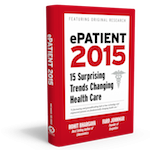
Co-authors Rohit Bhargava and Fard Johnmar clearly intended their new publication for people in the healthcare industry, with marketers among the primary beneficiaries of their forward-looking research.
Communicators—along with patients, providers and health executives—will value emerging ideas about empowerment, technology, innovation and ePatients. From this perspective, Rohit told us, marketing planners can “be informed about consumer activities, motivations for selecting and using digital health technologies, and broad industry trends that will influence how people are informed about health and wellness.”
“The goal of this book is to share 15 trends that are poised to fundamentally change the way health and medical care is delivered and received in the near future,” according to the authors. Their technology-and-issues timeline is current and contemporary, detailing trends that they conclude will be increasingly important between now and 2015 (and beyond).
Among the trends featured in the book—sometimes surprising by their counterintuitive nature—include:
- How Big Data may deliver “feel good” stats rather than real actionable health advice.
- Why it is critical that health innovators develop products that address differences in age, ethnicity and culture.
- What game theory teaches about changing health behavior and why rewards (or punishments) work—or don’t.
- How a “Device Divide” creates disparities among healthcare technology users.
- How the public will increasingly consider wellness criteria, such as walkable communities and hospital ratings, to decide where they should live and work.
Rather than to focus primarily on new technology and futuristic devices, the authors take what they describe as a “decidedly human-centric” approach. Throughout the book, the main concepts and individual trends are often illustrated with real-world and real people examples.
In addition, an extensive reference section and clickable “learn more” links throughout give depth to their observations and provide valuable resources for in-depth reading.
Worth reading for the long view…
In ePatient 2015 co-authors Bhargava and Johnmar cover a lot of territory and technology, looking ahead to the influence of mobile health devices, information technology, social media, genetics and more. Healthcare marketing professionals, medical executives, patients and providers will find a glimpse of the nearly-now future.

